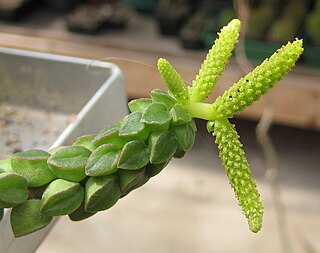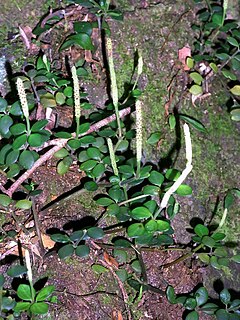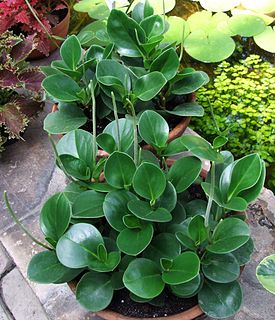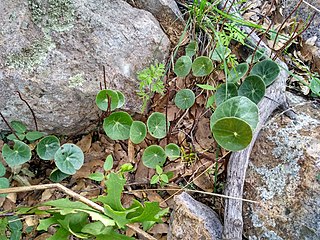
Peperomia is one of the two large genera of the family Piperaceae. It is estimated that there are at least over 1,000 species, occurring in all tropical and subtropical regions of the world, though concentrated in Central America and northern South America. A limited number of species are found in Africa. The exact number is difficult to tell as some plants have been recorded several times with different names and new species continue to be discovered. Peperomias have adapted to many different environments and their appearance varies greatly. Some are epiphytes or lithophytes, and many are xerophytes (drought-tolerant) either with thick succulent structures or with underground tubers (geophytes). Most species are compact perennial shrubs or vines.

Cyclamen is a genus of 23 species of perennial flowering plants in the family Primulaceae. Cyclamen species are native to Europe and the Mediterranean Basin east to the Caucasus and Iran, with one species in Somalia. They grow from tubers and are valued for their flowers with upswept petals and variably patterned leaves.
A storage organ is a part of a plant specifically modified for storage of energy (generally in the form of carbohydrates) or water. Storage organs often grow underground, where they are better protected from attack by herbivores. Plants that have an underground storage organ are called geophytes in the Raunkiær plant life-form classification system. Storage organs often, but not always, act as perennating organs which enable plants to survive adverse conditions.

Peperomia graveolens is a species of plant in the genus Peperomia of the family Piperaceae. It is endemic to Ecuador.
Peperomia litana is a species of plant in the family Piperaceae. It is endemic to Ecuador. It is a fairly small, glabrous herb with alternating subovate-elliptic leaves measuring approximately 1,5 by 2,5 cm. Resembles Peperomia vallensis and Peperomia suratana but differs from these by the shape of the leaves.

Peperomia nivalis is a species of plant in the genus Peperomia endemic to Peru. Its native habitat is found in the high altitude ranges of the peruvian Andes. P. nivalis is a compact erect succulent herb with fleshy stems and leaves. The thick leaves are cuneate and U-shaped in cross-section with epidermal windows on the top-side. The leaf color is bright green in the shady summer and reddish during dry sunny seasons.

Peperomia columella is a species of plant in the family Piperaceae. The species is endemic to Peru. It grows in dry areas, often in crevices on steep cliffs or in sandy soil. It grows to about 20 cm in height, forming snake-like stems, which carry closely packed succulent bright green leaves. The leaves are truncated, U-shape in cross-section, with epidermal windows on top. It can be kept as a houseplant and has received the Award of Garden Merit by the Royal Horticultural Society.

Peperomia tetraphylla, known as the acorn peperomia or four-leaved peperomia, is a small plant in the Peperomia genus and the Piperaceae family that grows natively in tropical and subtropical regions around the world. Additionally in can found on the Easter Islands and Hawaii as introduced species.

Peperomia obtusifolia, also known as the baby rubberplant, American rubber plant, or pepper face, is a species of flowering plant in the genus Peperomia under the family Piperaceae, native to Florida, Mexico and the Caribbean. The specific epithet obtusifolia means "blunt-leaved". The plant has gained the Royal Horticultural Society's Award of Garden Merit.

Peperomia serpens, the vining peperomia, is a species of flowering plant in the genus Peperomia and family Piperaceae, native to the New World Tropics. The plant is perennial.
Peperomia ferreyrae is a species of plant in the genus Peperomia native to Peru. It is a small, succulent herb, growing erect to about 20 cm in height. The alternating, typically 3 to 5 cm long leaves, are in the form of tubes resembling green bean pods: U-shaped in cross-section with epidermal windows on the top-side.

Peperomia maculosa, commonly known as spotted-stalked peperomia and spotted peperomia, is a species of plant in the genus Peperomia. Its native range is from Mexico to northern South America.

Peperomia nitida is a species of plant in the genus Peperomia. Its native range is in South America from Brazil to northern Argentina. It can be kept as a houseplant and is sometimes sold as cupid peperomia, or problematically as Peperomia scandens or Peperomia serpens. Peperomia serpens is a separate species with slightly more rounded leaves and its native region reaches further north to Mexico. The title scandens is occasionally applied to both, perhaps because both are vining plants, but officially Peperomia Scandens is considered a synonym for Peperomia serpens.
Peperomia peruviana is a species of flowering plant in the genus Peperomia. Its native range is in South America from Colombia to northern Argentina.
Peperomia umbilicata is a species of plant in the genus Peperomia. It is endemic to Peru. It is a geophytic plant, storing water and reserves in an underground tuber. During dry periods parts above ground, such as leaves, will wither away but the plant will survive due to the tuber. When more rain falls the plant regrows its stalks and leaves on the surface.

Peperomia bracteata is a species of plant in the genus Peperomia. Its native range covers Mexico and Guatemala. It is a geophytic plant, storing water and reserves in an underground tuber. During dry periods parts above ground, such as leaves, will wither away but the plant will survive due to the tuber. When more rain falls the plant regrows its stalks and leaves on the surface.

Peperomia monticola is a species of plant in the genus Peperomia. It's endemic to Mexico. It is a geophytic plant, storing water and reserves in an underground tuber. During dry periods parts above ground, such as leaves, will wither away but the plant will survive due to the tuber. When more rain falls the plant regrows its stalks and leaves on the surface.

Peperomia trifolia is a species of plant in the genus Peperomia. Its native range covers the Lesser Antilles and Trinidad.

Peperomia magnoliifolia, commonly known as the spoonleaf peperomia, is a species of plant in the genus Peperomia. Its native range reaches from parts of southern Florida and Mexico to the Caribbean and northern South America including Uruguay.

Peperomia fraseri, commonly known as the flowering pepper, is a species of plant in the genus Peperomia of the family Piperaceae. Its native range covers Colombia and Peru. It has also been introduced to Ecuador and Guatemala.














